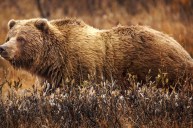Parks Canada officials described the wildfire raging through Jasper National Park as the largest in 100 years. Since it started on July 22, it has spread across some 79,000 acres and destroyed 358 structures, or about a third of the town of Jasper, Alberta. Plus, about 25,000 people had to evacuate their homes. With such rapid destruction, it's hard to imagine how anything caught in the path of the blaze survives, but where there's a will, there's a way.
In one sign of hope, Jasper Park officials shared images of a family of grizzly bears that managed to survive. They wrote in a Facebook post: "In the face of flames, the extraordinary instincts of wildlife, like bears and elk, guide them to safety." They explained that they tracked the sow, tagged Grizzly Bear 222, with its GPS collar. During the most extreme wildfire activity on July 24, the bears tucked themselves into a wet spot by the Athabasca River. In other words, they hid in the water and waited out the fire.
Monitoring wildlife during wildfires is part of management

Officials saw Grizzly Bear 222 with her cubs eating a mix of berries and clover on the edge of the park's golf course after the 2024 wildfire. Credit: Parks Canada/Facebook
James McCormick, a human-wildlife coexistence specialist with Parks Canada, explained that monitoring bears and other wildlife amid wildfires is an essential part of managing wildlife. While they want to know if anything died, they also want to make sure animals aren't eating trash or engaging in other activities that could lead to conflicts down the road.
"Because of all the fire and things that have been damaged, we're looking at trying to manage garbage, food waste and spoiled food," McCormick said. "We're also out trying to look for any animals that were physically impacted by the fire and we have seen some that perished to the fire."
Additionally, the other concern is that humans might try to approach dead animals. If that happens, you might accidentally engage a hungry bear. Officials say they spotted at least one grizzly eating an animal carcass amid the fires.
"One characteristic of a burned forest is that you can see quite a distance. We should have better opportunities to see if there are bears or a carcass in the area," McCormick said. "Always stay at least 200 meters from a bear on a carcass."
Fortunately, the sow and her cubs did not have to resort to eating human garbage. Instead, the park's wildlife team saw them eating a mix of berries and clover on the edge of the park's golf course. They added: "She looks like a very healthy grizzly bear right now."




